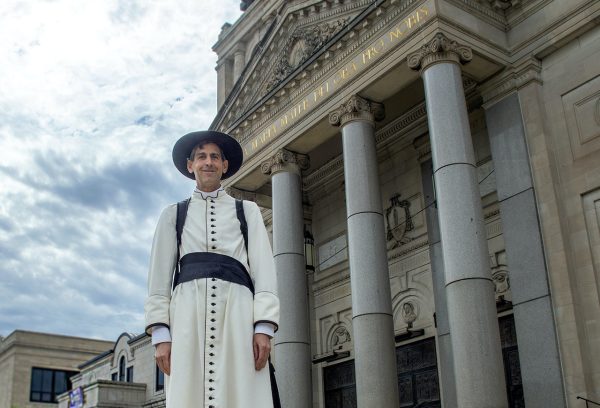Fr. Carney serving Benedictines, searching for lost souls

Fr. Lawrence Carney’s white cassock is useful when he walks the streets of a city. An inquirer may be drawn into a conversion about Jesus Christ as a result. (Advance photo)
Fr. Lawrence Carney, wearing a white cassock and a black saturno, walked the Camino de Santiago for over a month about nine years ago.
It changed his life, as it does for many who walk the Way of St. James.
“I met about a thousand people who wanted to talk about God, fallen-away Catholics, and others,” he said.
Those encounters weighed on his heart after he returned to the United States. He soon heard from a friend, the Benedictines of Mary Prioress Cecilia, who repeated a question she had previously asked: Would you be our chaplain?
Sister’s prayers are answered
Fr. Carney told her he loved Wichita and didn’t want to leave, but she persisted.
“On this camino, I learned how important it was to wear a cassock and talk to people who want to talk to me,” he said. “So, I said I’ll consider it if there’s any way I can walk around and meet people because out there in Gower (Missouri) there’s nobody walking around – just deer, and I can’t convert them.”
The prioress suggested nearby St. Joseph, Missouri, for souls to convert. Fr. Carney visited the city and was able to make arrangements to use the rectory there.
“So I called the Mother Prioress and said, ‘This will work.’ That’s how I became their chaplain. I walked the streets of St. Joe for five years.”
The status of the priory was raised to an abbey in 2018, he said. As a result, the mother prioress became the mother abbess.
Working with the sisters
For the last three and a half years – again with the bishop’s blessing – Fr. Carney worked even more closely with the Benedictines of Mary, Queen of Apostles. About a year ago Mother Abbess asked Father if he thought his mother and father would be able to find a place in Wichita for retreats for the nuns.
After discussing the matter with them, he said he thought perhaps Father Darrin May might be open to hosting them at the Spiritual Life Center in Wichita.
“So God’s will happened and now they’re making retreats here,” he said. “They’re just coming in little groups, praying for the bishop and praying for priests and the lay people and also for praying for my missionary work in the diocese, walking the streets.”
Fr. Carney has been assigned to the Benedictines for eight and a half years and will serve the nuns on retreat at the Spiritual Life Center where he celebrates Mass for the nuns, hears confessions, and leads adoration on Thursday and Sunday evenings. They come to Wichita in groups of four and stay for about a week. “They may have the idea of staying longer,” he said. “We’ll see how it goes. Mother Cecilia is very much open to divine providence.”
The number of nuns at the abbey has more than doubled from 21 to over 50 since they arrived in 2006 in Gower from the Diocese of Scranton, Pennsylvania.
Father’s street ministry
Fr. Carney said he’s a slow learner and it took him walking the streets of St. Joseph, Missouri, for six months before he realized he was doing exactly what Christ did. “He would walk and people would come to talk to him. It’s so simple.”
Jesus took the apostles out and slept under the stars, as Fr. Carney did while on his Camino. “You learn something when you’re out in nature – you’re closer to God. He talks to us in that way. That’s how his apostles were formed and that’s how they went out.”
St. James, St. Francis Xavier, and American missionary Fr. Pieter-Jan De Smet, were missionaries who went out into the world on foot, he said. “It paints a good picture for the Catholic Church. The church is willing to put a priest out there again, a missionary.”
Encountering those in need
Not only does that result in good will, Fr. Carney said, there are people he has encountered on the street who want to be baptized, who want to become Catholic. “I just go out and walk and pray the rosary. My mission is not to go to meet someone, it’s to pray to God and while I’m praying my rosary or my breviary, I’m talking to God – and when people ‘interrupt’ me I can share my contemplation with them and talk to them about God.”
Our Lord and St. Francis Xavier spent nights in prayer and then would share that with people, he said.
There isn’t a typical interaction with someone on the street, Fr. Carney said, but many times he will be questioned about his “gown.” He explains the history of the cassock, how the 33 buttons in front represent Jesus’ 33 years on earth, and how the five buttons on the sleeves represent Jesus’ five wounds.
“So it’s a walking sign of our Lord,” he said. “It’s actually a sacramental, it’s blessed – like a rosary it has grace that comes from the church.”
The questions from his encounters usually take different routes depending on whether the person is a Catholic or not, he said.
“The key is I want each person to have a good encounter so when they see me again they want to come back,” he said. “When I talk about that encounter with the nuns…I say to pray for this person. And the next time I see him your prayers will come with me and maybe God will take them to the next level. It’s not a sprint. It’s a marathon.”
Fr. Carney asked the faithful for their prayers for his ministry with the nuns and his street ministry.
